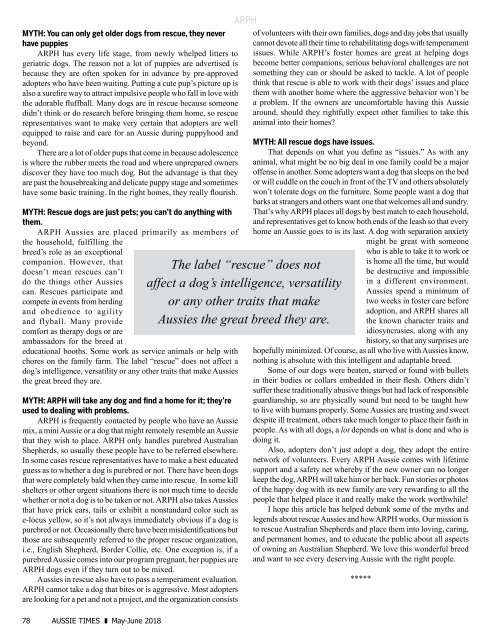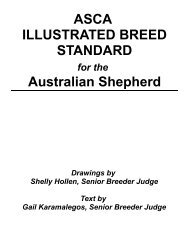2018 May June
Create successful ePaper yourself
Turn your PDF publications into a flip-book with our unique Google optimized e-Paper software.
MYTH: You can only get older dogs from rescue, they never<br />
have puppies<br />
ARPH has every life stage, from newly whelped litters to<br />
geriatric dogs. The reason not a lot of puppies are advertised is<br />
because they are often spoken for in advance by pre-approved<br />
adopters who have been waiting. Putting a cute pup’s picture up is<br />
also a surefire way to attract impulsive people who fall in love with<br />
the adorable fluffball. Many dogs are in rescue because someone<br />
didn’t think or do research before bringing them home, so rescue<br />
representatives want to make very certain that adopters are well<br />
equipped to raise and care for an Aussie during puppyhood and<br />
beyond.<br />
There are a lot of older pups that come in because adolescence<br />
is where the rubber meets the road and where unprepared owners<br />
discover they have too much dog. But the advantage is that they<br />
are past the housebreaking and delicate puppy stage and sometimes<br />
have some basic training. In the right homes, they really flourish.<br />
MYTH: Rescue dogs are just pets; you can’t do anything with<br />
them.<br />
ARPH Aussies are placed primarily as members of<br />
the household, fulfilling the<br />
breed’s role as an exceptional<br />
companion. However, that<br />
doesn’t mean rescues can’t<br />
do the things other Aussies<br />
can. Rescues participate and<br />
compete in events from herding<br />
and obedience to agility<br />
and flyball. Many provide<br />
comfort as therapy dogs or are<br />
ambassadors for the breed at<br />
educational booths. Some work as service animals or help with<br />
chores on the family farm. The label “rescue” does not affect a<br />
dog’s intelligence, versatility or any other traits that make Aussies<br />
the great breed they are.<br />
MYTH: ARPH will take any dog and find a home for it; they’re<br />
used to dealing with problems.<br />
ARPH is frequently contacted by people who have an Aussie<br />
mix, a mini Aussie or a dog that might remotely resemble an Aussie<br />
that they wish to place. ARPH only handles purebred Australian<br />
Shepherds, so usually these people have to be referred elsewhere.<br />
In some cases rescue representatives have to make a best educated<br />
guess as to whether a dog is purebred or not. There have been dogs<br />
that were completely bald when they came into rescue. In some kill<br />
shelters or other urgent situations there is not much time to decide<br />
whether or not a dog is to be taken or not. ARPH also takes Aussies<br />
that have prick ears, tails or exhibit a nonstandard color such as<br />
e-locus yellow, so it’s not always immediately obvious if a dog is<br />
purebred or not. Occasionally there have been misidentifications but<br />
those are subsequently referred to the proper rescue organization,<br />
i.e., English Shepherd, Border Collie, etc. One exception is, if a<br />
purebred Aussie comes into our program pregnant, her puppies are<br />
ARPH dogs even if they turn out to be mixed.<br />
Aussies in rescue also have to pass a temperament evaluation.<br />
ARPH cannot take a dog that bites or is aggressive. Most adopters<br />
are looking for a pet and not a project, and the organization consists<br />
ARPH<br />
The label “rescue” does not<br />
affect a dog’s intelligence, versatility<br />
or any other traits that make<br />
Aussies the great breed they are.<br />
of volunteers with their own families, dogs and day jobs that usually<br />
cannot devote all their time to rehabilitating dogs with temperament<br />
issues. While ARPH’s foster homes are great at helping dogs<br />
become better companions, serious behavioral challenges are not<br />
something they can or should be asked to tackle. A lot of people<br />
think that rescue is able to work with their dogs’ issues and place<br />
them with another home where the aggressive behavior won’t be<br />
a problem. If the owners are uncomfortable having this Aussie<br />
around, should they rightfully expect other families to take this<br />
animal into their homes?<br />
MYTH: All rescue dogs have issues.<br />
That depends on what you define as “issues.” As with any<br />
animal, what might be no big deal in one family could be a major<br />
offense in another. Some adopters want a dog that sleeps on the bed<br />
or will cuddle on the couch in front of the TV and others absolutely<br />
won’t tolerate dogs on the furniture. Some people want a dog that<br />
barks at strangers and others want one that welcomes all and sundry.<br />
That’s why ARPH places all dogs by best match to each household,<br />
and representatives get to know both ends of the leash so that every<br />
home an Aussie goes to is its last. A dog with separation anxiety<br />
might be great with someone<br />
who is able to take it to work or<br />
is home all the time, but would<br />
be destructive and impossible<br />
in a different environment.<br />
Aussies spend a minimum of<br />
two weeks in foster care before<br />
adoption, and ARPH shares all<br />
the known character traits and<br />
idiosyncrasies, along with any<br />
history, so that any surprises are<br />
hopefully minimized. Of course, as all who live with Aussies know,<br />
nothing is absolute with this intelligent and adaptable breed.<br />
Some of our dogs were beaten, starved or found with bullets<br />
in their bodies or collars embedded in their flesh. Others didn’t<br />
suffer these traditionally abusive things but had lack of responsible<br />
guardianship, so are physically sound but need to be taught how<br />
to live with humans properly. Some Aussies are trusting and sweet<br />
despite ill treatment, others take much longer to place their faith in<br />
people. As with all dogs, a lot depends on what is done and who is<br />
doing it.<br />
Also, adopters don’t just adopt a dog, they adopt the entire<br />
network of volunteers. Every ARPH Aussie comes with lifetime<br />
support and a safety net whereby if the new owner can no longer<br />
keep the dog, ARPH will take him or her back. Fun stories or photos<br />
of the happy dog with its new family are very rewarding to all the<br />
people that helped place it and really make the work worthwhile!<br />
I hope this article has helped debunk some of the myths and<br />
legends about rescue Aussies and how ARPH works. Our mission is<br />
to rescue Australian Shepherds and place them into loving, caring,<br />
and permanent homes, and to educate the public about all aspects<br />
of owning an Australian Shepherd. We love this wonderful breed<br />
and want to see every deserving Aussie with the right people.<br />
*****<br />
78 AUSSIE TIMES <strong>May</strong>-<strong>June</strong> <strong>2018</strong>



